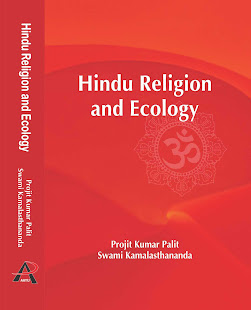
Hindu Religion and Ecology
Projit Kumar Palit Swami Kamalasthananda
ISBN: 9789391685096, 9391685099
Sale Price: INR 1600.00
Discount: 10.00%
INR 1440.00 You Save: INR 160.00
Title: Hindu Religion and Ecology
Author: Projit Kumar Palit Swami Kamalasthananda
ISBN 13: 9789391685096
ISBN 10: 9391685099
Year: 2022
Language: English
Pages etc.: 396p crown
Binding: Hardbound
Aayu Publications
The concept of ecology and its role play an integral part in the development of culture and civilization of human beings. The Vedas and other Brahminical literatures universally acknowledged everything of nature which is embodied under the sun. The Vedas and other literatures deal with knowledge and the knowledge covers both ecological and philosophical aspects of nature. The oldest and simplest form of nature-worship finds expression in Vedic texts. Many scholars have come to the conclusion that the Vedas are primarily concerned with cosmology, however, they are not in a position to show that Vedic cosmology has the solutions to the most difficult problems of modern cosmology. As Sanskrit literature is so wide we refer here mainly to Vedic texts, particularly the Vedic Samhitas, Upanishads and Epics for our study of ecological awareness. The living organisms can be grouped into three types – those living mainly on land, in water and in air. The non-living materials of the environment are land, air, water, property etc. In modern Sanskrit, the word Paryavarana is used for environment, meaning which encircles us, which are all around in our surroundings but in the Atharvaveda words equivalent to this sense are used such as Vritavrita, Abhivarah, Avritah, Parivrita etc. The Vedic view on environment is well-defined in one verse of the Atharvaveda where three coverings of our surroundings are referred as Chandamsi. These are water, air and plants or herbs. They exist in the world from the very beginning. They are called as Chandamsi meaning 'coverings available everywhere.' It proves the knowledge of Vedic seers about the basic elements of environment. According to one indigenous theory established in the Upanishads, the universe consists of five basic elements viz., (i) Earth or land, (ii) water, (iii) light or lustre, (iv)air, and (v) ether. The nature has maintained a status of balance between and among these constituents or elements and living creatures. A disturbance in percentage of any constituent of the environment beyond certain limits disturbs the natural balance and any change in the natural balance causes lots of problems to the living creatures in the universe. Different constituents of the environment exist with set relationships with one another. The relation of a human being with the environment is very natural as he cannot live without it. From the very beginning of creation he wants to know about it for self-protection and benefit.
We Accept Online Secure Payment
